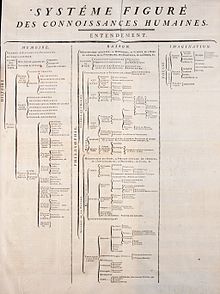|
Figurative system of human knowledge The "figurative system of human knowledge" (French: Système figuré des connaissances humaines), sometimes known as the tree of Diderot and d'Alembert, was a tree developed to represent the structure of knowledge itself, produced for the Encyclopédie by Jean le Rond d'Alembert and Denis Diderot. The tree was a taxonomy of human knowledge, inspired by Francis Bacon's The Advancement of Learning. The three main branches of knowledge in the tree are: "Memory"/History, "Reason"/Philosophy, and "Imagination"/Poetry. Notable is the fact that theology is ordered under philosophy. The historian Robert Darnton has argued that this categorization of religion as being subject to human reason, and not a source of knowledge in and of itself (revelation), was a significant factor in the controversy surrounding the work.[1] "Knowledge of God" is only a few nodes away from divination and black magic. The original version, in French, can be seen in the graphic on the right. An image of the diagram with English translations superimposed over the French text is available. Another example of English translation of the tree is available in literature (see the reference by Schwab). Below is a version of it rendered in English as a bulleted outline. The Tree of Diderot and d'Alembert"Detailed System of Human Knowledge" from the Encyclopédie.
(Note: This next branch seems to belong to both the narrative and dramatic tree, as indicated by the line drawn connecting the two.)
See alsoReferences
Further reading
External links
Information related to Figurative system of human knowledge |